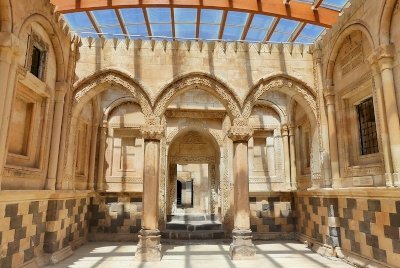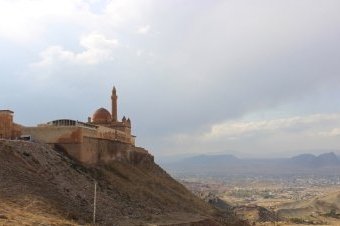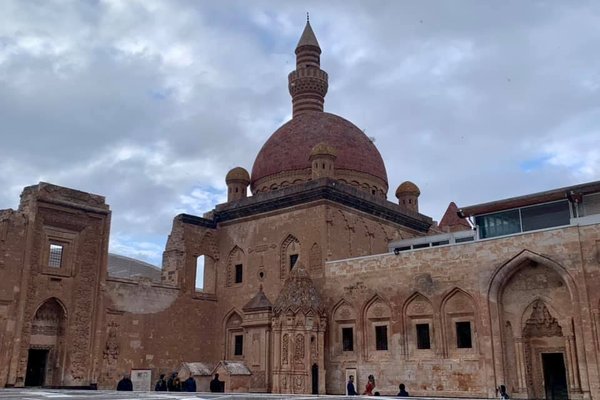Turkiye
Ishak Pasha Palace
The Ishak Pasha Palace was an 18th-century palace, administrative center and military fort.
It is strategically located on a platform near the road to Iran. Three of its outer walls rise directly above steep, rocky slopes. Its architectural style mixes different traditions. The decorated east portal dominates the façade.
Site Info
Official Information
- Full Name
- Ishak Pasha Palace (ID: 1410)
- Country
- Turkiye
- Status
-
On tentative list 2000
Site history
History of Ishak Pasha Palace
- 2000: Added to Tentative List
- Added to tentative list
- Type
- Cultural
- Criteria
Links
- UNESCO
- whc.unesco.org
- Related
-
- de.wikipedia.org — Entry on German Wikipedia
All Links
UNESCO.org
- whc.unesco.org — whc.unesco.org
Related Resources
- de.wikipedia.org — Entry on German Wikipedia
News Article
- Oct. 13, 2025 turkiyetoday.com — Ishak Pasha Palace begins groundwork to move from UNESCO tentative list to main register
Community Information
- Community Category
- Secular structure: Palace
Travel Information
Recent Connections
News
- turkiyetoday.com 10/13/2025
- Ishak Pasha Palace begins groundwo…
Recent Visitors
Visitors of Ishak Pasha Palace
- Afshin Iranpour
- Alexander Lehmann
- A. Mehmet Haksever
- AYB
- bergecn
- Can SARICA
- Cheryl
- christof
- Cluckily
- Clyde
- Corinne Vail
- Dimitar Krastev
- Els Slots
- Erik Jelinek
- George Gdanski
- henryjiao18
- John Smaranda
- Kevin McFarland
- Roman Bruehwiler
- Thomas Buechler
- Thomas van der Walt
- tony0001
- Walter
- Wojciech Fedoruk
Community Reviews
Show full reviews
I visited this tWHS in Spring 2021 as a pleasant stopover between Van and Ani WHS. Its beautiful surroundings at the foothills of Mount Ararat and with lovely wild flowers everywhere in full bloom made it a worthwhile stop in such a remote part of Turkey, near Doğubeyazıt, close to the border with Iran and Armenia.
The palace's tall and ornate exterior facade already hints at the palace's "interior" beauty. Well, "interior" as in covered with a huge glass and metal roof since most of the palace's roof was lost due to an earthquake. The Ishak Pasha Palace construction was started by Kurdish chiefs from the Besyan tribe of Beyazıd Sanjak and it was completed in 1784 by the Kurdish sanjak chief Ishak Pasha. The Ishak Pasha Palace is one of the few examples of surviving historical palaces on the silk route and as such has potential OUV to become a WHS. Although it represents the Ottoman tradition, in actual fact it is rather a mixture of Anatolian, Iranian, Armenian and North Mesopotamian architectural tradition. The traditional model used in the construction of the royal palaces in the capital cities like Bursa, Edirne and Istanbul was taken as an example in the design of the Ishak Pasha Palace. Moreover, the Western influence in Ottoman architecture during the post-Classical period can also be observed. Apart from the palace, it is also possible to visit Urartian rock tombs discovered in 1830.
Although most of the different sections of the palace …
Keep reading 0 comments
Ishak Pasha Palace is in Eastern Turkey, close to the Irananian border. It stands strategically on a platform above the Sariova plain, surrounded by some of Turkish’s highest peaks, including Mount Ararat. It controls a strategic stretch of the Silk Road, a few kilometers above the town of Dogubayazit.
I visited this palace in october 2018 while driving from Van to Kars (on the way to visit Ani WHS). Dogubayazit is about half-way. Roads are in very good condition. There are numerous police checks, as it is close to the Iranian border, but nothing to worry about.
The palace is quite recent, having been built by local pashas in the 18th century. It served as a palace but also as an administrative center. It mixes Anatolian, Iranian and North Mesopotamian architectural tradition. It was badly damaged by successive wars and an earthquake. Most of the roofs have collapsed and have been replaced by a glass footop. Entrance is through a very nicely decorated portal with Seldjuk features and costs 6 lira. There are two courtyards, the second one the nicest with views on the mosque’s dome and the mausoleums in which the pashas rest. The harem section is well preserved with spectacularly decorated rooms and remains of central heating control. The view on the plain below with the town is spectacular. Mount Ararat is hidden behind hills however, but is seem again as soon as going back down.
Ishak Pasha Palace is a nice site, …
Keep reading 0 comments
